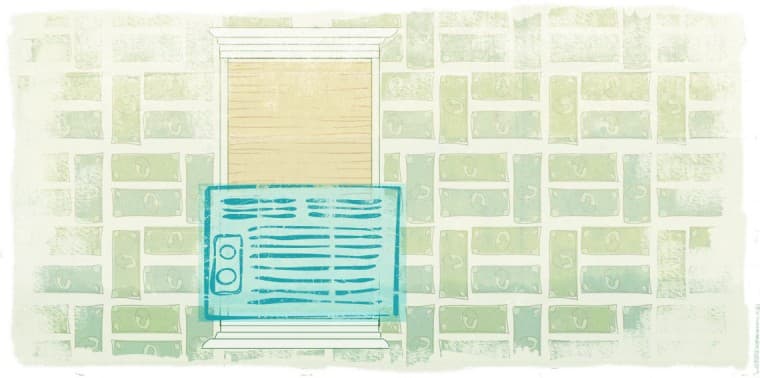Air conditioning is not the enemy
Carbon pollution is.

In my book, But Will the Planet Notice?, I proudly proclaim to live in a one-bedroom apartment without air conditioning.
No longer.
My wife, young son and I just moved from New York City to Cambridge, Mass., into a three-bedroom apartment with plenty of space to play and sleep comfortably — the joys of living anywhere other than in Manhattan, I suppose. We also installed our very first air-conditioning units to help cope with the ever longer and more frequent heat waves.
This ought to be embarrassing for an environmentally minded guy like me to admit. I’m a vegetarian. I don’t drive. I’ve used the same water bottle for five years, the same cotton canvas bag for 10. I just won the “most eco-friendly” staff competition at the Environmental Defense Fund, where I am a senior economist, by taking all sorts of eco-friendly steps in a given week — including running 8 miles to work each morning.
Last summer, while still living in New York, instead of succumbing to the desire for our own air conditioner, we would take our then 1-year-old to the American Museum of Natural History every day — not for the blue whale, but to walk the cool halls for a good midday nap in his buggy. During the hot, muggy summer nights, we would sleep with a highly efficient fan blasting at us on full speed.
Now that I have air conditioning, I can say I like it — to a point. I’d much rather breathe crisp, clear mountain air or experience a pleasant sea breeze. But, while Cambridge has a lot to offer, pleasant summer temperatures aren’t on the list. Air conditioning makes living here much more enjoyable and productive.
I’m not alone. Air conditioners account for around 5 percent of electricity used in the U.S. The need for more air conditioning is one of the costliest effects of global warming. Its use, in turn, leads to more warming, which leads to a greater need for air conditioning — just one example of the changing climate’s many feedback loops. As a result, the costs of global warming are rising year after year. Meanwhile, lack of air conditioning is the reason higher temperatures reduce economic growth in poor countries. There is little effect on the economies in rich countries that can afford air conditioning.
The solution to this vicious cycle?
Energy efficiency is one important answer. That means buying the most efficient cooling units, taping your windows and insulating your home to have air conditioners work to their full potential. It also means strong building codes to reduce the need for cooling in the first place. California is a good place to look for such policies. Sure, most of the state is blessed with pleasant temperatures year round that greatly reduce the need for air conditioning and heating. Still, as early as the 1970s, California has been a pioneer when it comes to implementing energy efficiency standards — on everything from buildings to air conditioners. All that has contributed to a sizeable divergence in electricity use from the rest of the country: California’s residential per capita electricity use has stayed constant since the ’70s, while overall U.S. residential use has more than doubled. California’s energy efficiency policies have contributed at least 20 percent of that difference.
But to truly change the equation, we need to change the way we produce electricity.
At midday on a sunny summer day — when demand is down and the sun is up — solar power can provide nearly 50 percent of Germany’s electricity. During those times, Germans can turn on their air conditioners with at least half a clear conscience, knowing that part of their power source is emitting zero greenhouse gas pollution. (Germany’s strong building codes, by the way, dramatically decrease the need for air conditioning in the first place.)
But until the world transitions to a clean energy economy, which isn’t going to happen overnight, the only way to break the cycle of using more fossil-based energy to stay cool (or to do anything that we’ve become accustomed to doing that relies on fossil fuels), is to make people pay the cost of their own emissions. And voluntarily offsetting emissions isn’t enough here. We can’t only rely on a few eco-pioneers to make a personal sacrifice. The solution must involve all of us. For that to happen, we’ll need appropriate policies at the city, state and federal levels: everything from building codes to energy-efficiency appliance standards to caps or taxes on carbon pollution.
Last year, California took a further step: a comprehensive cap-and-trade system that limits overall emissions and enables businesses to meet the emissions reductions requirements as cost-effectively as possible. No top-down demands on how emissions ought to be reduced, just a mandate that they go down. As a result, Californians are now incorporating (part of) the costs of air pollution due to air conditioning into their daily decisions, without anyone telling them if or when to turn on their air conditioners or which one to buy in the first place. It’s the most flexible — and, thus, most cost-effective — way to decrease emissions. It also happens to be a no-brainer solution when it comes to weighing societal benefits and costs, with benefits dwarfing costs to the tune of three to one and more.
Ultimately, this approach is the best way of breaking the cycle. No one is asking anyone to give up air conditioning — only to include the full costs of one’s energy use.
After all, air conditioning isn’t the enemy. Carbon pollution is.
Published on Ensia.com on August 8th, 2013.

